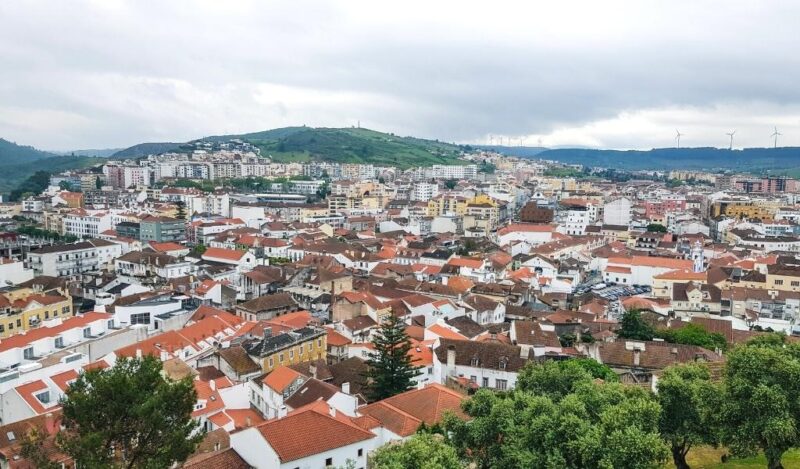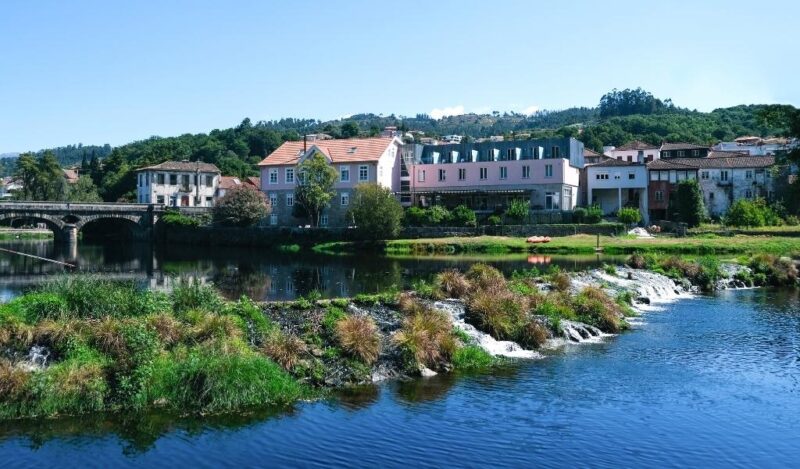Óbidos is a very picturesque town located in the Leiria district. Here, you can walk along the centuries-old walls, discover where a long 16th-century aqueduct ends, and even climb a medieval castle, which was elected one of the “7 Wonders of Portugal” in 2007!
With a relatively small historic center (but very well preserved), Óbidos is an excellent option for a day trip from Lisbon. Or, as a stop on a road trip through the Central Region of Portugal!
And if you can’t decide when to visit this Portuguese town, don’t worry. There are several festivals and fairs throughout the year, which not only make Óbidos an even more interesting destination but can also make your trip much more special!
So, do you want to know more about 1 Day In Óbidos: The Perfect Óbidos Itinerary? Keep reading!
This post may contain affiliate links, meaning I earn a small commission if you make a purchase, at no additional cost to you. Please read my disclosure & privacy policy for more information.
No time to read now? Pin it for later!


Brief History of Óbidos
Like many other villages, towns, and cities in this area of Portugal, Óbidos was conquered from the Moors in 1148, during the Christian Reconquista of the Iberian Peninsula.
And after having received its first Charter by King Sancho I in 1195, Óbidos became known as the “Town of Queens”. Do you know why? Because this was one of the lands that the Portuguese monarchs have offered their respective wives as a wedding dowry, for over six centuries!


Until March 18th, 1834 (the date on which the so-called “House of Queens” was dissolved), many Portuguese queens were given the responsibility of administering the town of Óbidos, contributing to its growth and development. Among them, stand out the actions of:
- Queen Urraca of Castile (wife of King Afonso II)
- Queen Elizabeth of Aragon, better known as Queen Saint Elizabeth (spouse of King Denis I)
- Queen Philippa of Lancaster (wife of King John I)
- Queen Eleanor of Aragon (spouse of King Edward I)
- Queen Isabel of Coimbra (wife of King Afonso V)
- Queen Eleanor of Viseu (spouse of King John II)
- Queen Catherine of Austria (wife of King John III)
- Queen Maria Anna of Austria (spouse of King John V)
- Queen Maria I, the first Queen of Portugal (married to King Peter III)
Visiting Óbidos
The town of Óbidos is located about 85 km from Lisbon, which makes it a perfect destination for a day trip from the Portuguese capital. In addition, it’s a place well known for its themed events, among which four stand out:
- Óbidos International Chocolate Festival – this gastronomic festival is held in spring and brings together some of the best Master Chocolatiers and Pastry Chefs in the world
- Óbidos Medieval Fair– this medieval fair is one of the most authentic in the country and takes place between July and August, attracting many national and foreign tourists
- Óbidos International Literary Festival (FOLIO) – this festival is celebrated between September and October and is included in the project “Óbidos Literary Town”, as Óbidos has been part of the UNESCO Creative Cities Network since 2015
- Óbidos Christmas Town – as the name implies, this event aims to recreate the spirit of the European Christmas markets, with the originality of being inserted in a medieval landscape
Óbidos Itinerary
Town Gate
The first stop on this itinerary about the “Best Things to Do in Óbidos” is the Town Gate, which has been a National Monument since 1910. Built at the end of the 14th century, this double door is one of the original openings in the medieval wall, and nowadays, it serves as the main entrance to the historical town.


Inside, it’s impossible not to stop to admire the wonderful oratory dedicated to Our Lady of Piety (the Patron Saint of Óbidos), dating from the 17th century. It’s decorated by a series of tile panels, which were added in the mid-18th century and depict different episodes from the Holy Bible.
Saint Mary’s Church
Saint Mary’s Church (or Church of Our Lady of the Assumption) is the Parish Church of Óbidos. Erected in the 12th century, it received interventions in the 16th and 17th centuries, which resulted in a mixture of architectural styles: Renaissance, Mannerist, and Baroque.
Visiting this Catholic temple is one of the best things to do in Óbidos, because of its artistic heritage. For example, in its interior, you’ll find the Tomb of João de Noronha and Isabel de Sousa (the alcaide of the town and his wife), a piece that dates from the first half of the 16th century and was classified as a Monument National in 1933.

Also, don’t miss the fantastic altarpiece in the Chapel of Saint Catherine, made by Josefa de Óbidos in 1661. And of course, the tile covering on the church walls, which was designed between the end of the 17th century and the beginning of the 18th century!
Town Fountain

The Town Fountain (also known as the Fountain of Saint Mary’s Square) is located in front of Saint Mary’s Church, in the heart of the historic center of Óbidos.
Saint Mary’s Square was expanded in the 16th century and gained its final disposition in the reign of Catherine of Austria. From this point onwards, in addition to the Parish Church and the Town Fountain, are preserved monuments such as the Pillory, the Town Market, the Aboins Manor House, the Brito Pegado Manor House (or Manor House of Saint Mary’s Square, now the Municipal Museum of Óbidos) and the Former Town Hall (today, the Abílio de Mattos e Silva Museum).
Constructed in Mannerist style, the Town Fountain was supplied by water from the Óbidos Aqueduct (or Usseira Aqueduct) – another essential infrastructure commissioned by Queen Catherine of Austria, at the end of the 17th century.
Saint James’ Church
Saint James’ Church (sometimes called Santiago’s Church) is an imposing religious building that forms part of the inner wall of the Óbidos Castle.
The first records of this church date back to the year 1186, when King Sancho I decided to add a Catholic church to serve the military fortress.
Unfortunately, Saint James’ Church was completely destroyed in the Lisbon Earthquake of 1755. As a result, a new temple was built in baroque and neoclassical style, which differed significantly from its original architecture (in the Gothic style).

At the end of the 1980s, the monument was transferred to the Óbidos City Council, which transformed it into a municipal auditorium. These days, Saint James’ Church is one of the best things to do in Óbidos, as it houses a bookshop with the same name!
Óbidos Castle

Óbidos Castle is the most visited monument in this Portuguese town – especially since it was distinguished as one of the “7 Wonders of Portugal” on July 7th, 2007!
After being occupied by Lusitanians, Romans, Visigoths, and Muslims between the 4th BC and 12th centuries AD, the military fortress was conquered by King Afonso Henriques and reformulated by King Sancho I, his successor.
King Afonso II, the latter’s heir, was the first king to offer his wife the town of Óbidos, including its medieval castle.
Of the remaining monarchs that succeeded, the towers built by King Dinis and King Fernando, as well as the reform carried out by D. Manuel I – culminating in an architectural work with Romanesque, Gothic, Manueline and Baroque elements – are noteworthy.
Medieval Walls
If you’re looking for the best things to do in Óbidos, let me tell you that there are several experiences related to its Medieval Walls! How about starting by climbing one of the several flights of stairs scattered around the walled enclosure? Wherever you climb, you’ll be able to enjoy the panoramic views of the Portuguese town and its surrounding landscape!

Another activity not to be missed in Óbidos is to walk along these centuries-old walls, going around practically the entire medieval town. Along the way, take the opportunity to photograph the various perspectives and angles of its historic houses, which look like something out of a fairy tale!
Óbidos Aqueduct
As I mentioned earlier, the Óbidos Aqueduct was built in the 1570s, at the request of Queen Catherine of Austria. The monarch was so dedicated to this town and its population that she financed the work in full, receiving in exchange a large fertile plain (called Queen’s Floodplain)!

And even though the Óbidos Aqueduct is known as such on the international scene, the Portuguese call it the Usseira Aqueduct (named after a parish in the municipality of Óbidos). This is because it was in this area that the water source which supplied the nearly 3 kilometers of extension of this Mannerist archery work was located!
Bacalhôa Buddha Eden Garden
Although the Bacalhôa Buddha Eden Garden is not part of the municipality of Óbidos, I decided to include it in this itinerary, as it’s only 15 km away from the town. In fact, on the day I visited Óbidos, I ended up spending the morning in the medieval town and the afternoon in this garden of peace and tranquility, so I recommend you do the same!
The Bacalhôa Buddha Eden is the largest oriental garden in Europe, with about 35 hectares. Composed of various types of green spaces with lakes and statues, it’s a true tribute to different Asian cultures and religions. Here, you’ll be able to wander among Buddhas, pagodas, terracotta soldiers, ponds with Koi carps, and dragons carved in stone!
Map of the Óbidos Itinerary
Share this blog post on your social media!
More Posts about Portugal
4 Best Monasteries In Portugal (That You Should Visit This Year)
5 Best Palaces In Sintra (That You Should Visit This Year)
1 Day In Penafiel: The Perfect Penafiel Itinerary
More Posts about Travel Itineraries
1 Day In Penafiel: The Perfect Penafiel Itinerary
1 Day In Torres Vedras: The Perfect Torres Vedras Itinerary
2 Days In Arcos De Valdevez: The Perfect Arcos De Valdevez Itinerary
What Photography Gear Do I Use?
- Camera Body: Fujifilm X-T4 Mirrorless
- Camera Lens: Fujinon XF 18-55 mm F2.8-4 R LM OIS
- Tripod: Manfrotto Compact Action
- Small Tripod: Manfrotto PIXI Mini
- Smartphone Adaptor: Manfrotto PIXI Clamp
- Memory Card: SanDisk 128GB Extreme PRO SDXC





